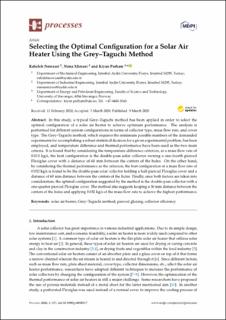| dc.contributor.author | Nowzari, Raheleh | |
| dc.contributor.author | Mirzaei, Nima | |
| dc.contributor.author | Parham, Kiyan | |
| dc.date.accessioned | 2020-08-18T11:57:51Z | |
| dc.date.available | 2020-08-18T11:57:51Z | |
| dc.date.created | 2020-03-09T16:12:15Z | |
| dc.date.issued | 2020-03 | |
| dc.identifier.citation | Parham, K., Nowzari, R., Mirzaei, N. (2020) Selecting the Optimal Configuration for a Solar Air Heater Using the Grey–Taguchi Method. Processes, 8 (3), pp. 1-11. | en_US |
| dc.identifier.issn | 2227-9717 | |
| dc.identifier.uri | https://hdl.handle.net/11250/2672817 | |
| dc.description.abstract | In this study, a typical Grey–Taguchi method has been applied in order to select the optimal configuration of a solar air heater to achieve optimum performance. The analysis is performed for different system configurations in terms of collector type, mass flow rate, and cover type. The Grey–Taguchi method, which requires the minimum possible numbers of the demanded experiments for accomplishing a robust statistical decision for a given experimental problem, has been employed, and temperature difference and thermal performance have been used as the two main criteria. It is found that by considering the temperature difference criterion, at a mass flow rate of 0.011 kg/s, the best configuration is the double-pass solar collector owning a one-fourth pierced Plexiglas cover with a distance of 60 mm between the centers of the holes. On the other hand, by considering the thermal performance as the criterion, the best configuration at a mass flow rate of 0.032 kg/s is found to be the double-pass solar collector holding a half-pierced Plexiglas cover and a distance of 60 mm distance between the centers of the holes. Finally, once both factors are taken into consideration, the optimal configuration suggested by the method is the double-pass collector with a one-quarter pierced Plexiglas cover. The method also suggests keeping a 30 mm distance between the centers of the holes and applying 0.032 kg/s of the mass flow rate to achieve the highest performance. | en_US |
| dc.language.iso | eng | en_US |
| dc.publisher | MDPI | en_US |
| dc.rights | Attribution-NonCommercial-NoDerivatives 4.0 Internasjonal | * |
| dc.rights.uri | http://creativecommons.org/licenses/by-nc-nd/4.0/deed.no | * |
| dc.subject | solar air heater | en_US |
| dc.subject | Grey–Taguchi method | en_US |
| dc.subject | pierced glazing | en_US |
| dc.title | Selecting the Optimal Configuration for a Solar Air Heater Using the Grey–Taguchi Method | en_US |
| dc.type | Peer reviewed | en_US |
| dc.type | Journal article | en_US |
| dc.description.version | publishedVersion | en_US |
| dc.rights.holder | © 2020 by the authors | en_US |
| dc.subject.nsi | VDP::Teknologi: 500 | en_US |
| dc.source.pagenumber | 1-11 | en_US |
| dc.source.volume | 8 | en_US |
| dc.source.journal | Processes | en_US |
| dc.source.issue | 3 | en_US |
| dc.identifier.doi | https://doi.org/10.3390/pr8030317 | |
| dc.identifier.cristin | 1800708 | |
| cristin.ispublished | true | |
| cristin.fulltext | original | |
| cristin.qualitycode | 1 | |

